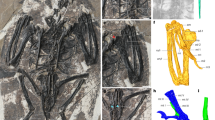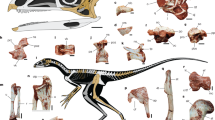Abstract
Here we describe a new triconodont mammal from the Late Jurassic/Early Cretaceous period of Liaoning, China. This new mammal is represented by the best-preserved skeleton known so far for triconodonts which form one of the earliest Mesozoic mammalian groups with high diversity. The postcranial skeleton of this new triconodont shows a mosaic of characters, including a primitive pelvic girdle and hindlimb but a very derived pectoral girdle that is closely comparable to those of derived therians. Given the basal position of this taxon in mammalian phylogeny, its derived pectoral girdle indicates that homoplasies (similarities resulting from independent evolution among unrelated lineages) are as common in the postcranial skeleton as they are in the skull and dentition in the evolution of Mesozoic mammals. Limb structures of the new triconodont indicate that it was probably a ground-dwelling animal.
This is a preview of subscription content, access via your institution
Access options
Subscribe to this journal
Receive 51 print issues and online access
$199.00 per year
only $3.90 per issue
Buy this article
- Purchase on Springer Link
- Instant access to full article PDF
Prices may be subject to local taxes which are calculated during checkout





Similar content being viewed by others
References
Ji, Q. & Ji, S. -A. Discovery of the earliest bird fossils in China and the origin of birds. Chinese Geol. 1996 , 30–33 (1996).
Hou, L., Martin, L. D., Zhou, Z. & Feduccia, A. Early adaptive radiation of birds: evidence from fossils from Northeastern China. Science 274, 1164–1165 ( 1996).
Hu, Y., Wang, Y., Luo, Z. & Li, C. Anew symmetrodont mammal from China and its implications for mammalian evolution. Nature 390, 137–142 ( 1997).
Chen, P. -J., Dong, Z. -M. & Zhen, S. -N. An exceptionally well-preserved theropod dinosaur from the Yixian Formation of China. Nature 391, 147–152 (1998).
Ji, Q., Currie, P. J., Norell, M. A. & Ji, S. -A. Two feathered dinosaurs from northeastern China. Nature 393, 753–761 (1998).
Kermack, K. A., Mussett, F. & Rigney, H. W. The lower jaw of Morganucodon. Zool. J. Linn. Soc. 53, 87–175 (1973).
Crompton, A. W. The dentitions and relationships of the southern African Triassic mammals Erythrotherium parringtoni and Megazostrodon rudnerae. Bull. Br. Mus. Nat. Hist. 24, 399– 437 (1974).
Luo, Z. in In the Shadow of Dinosaurs — Early Mesozoic Tetrapods(eds Fraser, N. C. & Sues, H.-D.) 980–128 (Cambridge Univ. Press, Cambridge, (1994).
Jenkins, F. A. J & Schaff, C. R. The Early Cretaceous mammal Gobiconodon (Mammalia, Triconodonta) from the Cloverly Formation in Montana. J. Vert. Paleontol. 6, 1– 24 (1988).
Kielan-Jaworowska, Z. & Dashzeveg, D. New Early Cretaceous amphilestid (‘triconodont’) mammals from Mongolia. Acta Palaeont. Polonica. 43, 413–438 (1998).
Fox, R. C. Additions to the mammalian local fauna from the upper Milk River Formation (Upper Cretaceous), Alberta. Can. J. Earth Sci. 13, 1105–1118 (1976).
Jenkins, F. A. J & Crompton, A. W. in Mesozoic Mammals: The First Two-thirds of Mammalian History(eds Lillegraven, J. A., Kielan-Jaworowska, Z. & Clemens, W. A.) 74– 90 (Univ. Calif. Press, Berkeley, (1979).
Cifelli, R. L., Wible, J. R. & Jenkins, F. A. J Triconodont mammals from the Cloverly Formation (Lower Cretaceous), Montana and Wyoming. J. Vert. Paleontol. 16, 237–241 (1998).
Sigogneau-Russell, D. Two possibly aquatic triconodont mammals from the Early Cretaceous of Morocco. Acta Palaeont. Polonica 40, 149– 162 (1995).
Simpson, G. G. A catalogue of the Mesozoic Mammalia in the Geological Department of the British Museum(Oxford Univ. Press, London, (1928).
Sun, A. & Li, Y. The postcranial skeleton of the late tritylodont Bienotheroides. Vert. PalAsiat. 23, 136–151 (1985).
Klima, M. Die Frühentwicklung des Schültergürtels und des Brustbeins bei den Monotremen (Mammalia: Prototheria). Adv. Anat. Embryol. Cell Biol. 47, 1–80 ( 1973).
Krause, D. W. & Jenkins, F. A. J The postcranial skeleton of North American multituberculates. Bull. Mus. Comp. Zool. 150, 199–246 (1983).
Kielan-Jaworowska, Z. & Gambaryan, P. P. Postcranial anatomy and habits of Asian multituberculate mammals. Fossils Strata 36, 1–92 (1994 ).
Sereno, P. & McKenna, M. C. Cretaceous multituberculate skeleton and the early evolution of the mammalian shoulder girdle. Nature 377, 144–147 ( 1995).
Jenkins, F. A. J & Weijs, W. A. The functional anatomy of the shoulder in the Virginia opossum (Didelphis virginiana). J. Zool. 188, 379–410 (1979).
Jenkins, F. A. J The postcranial skeleton of African cynodonts. Bull. Peabody Mus. Nat. Hist. Yale Univ. 36, 1–216 (1971).
Jenkins, F. A. J & Parrington, F. R. Postcranial skeleton of the Triassic mammals Eozostrodon, Megazostrodon, and Erythrotherium. Phil. Trans. R. Soc. Lond. B 273, 387–431 (1976).
Rougier, G. W. Vincelestes neuquenianus Bonaparte (Mammalia, Theria), un primitivo mammifero del Cretacico Inferior de la Cuenca Neuqina. Thesis, Univ. Nacional de Buenos Aires(1993).
McLeod, N. & Rose, K. D. Inferring locomotory behavior in Paleogene mammals via eigenshape analysis. Am. J. Sci. 293, 300–355 (1993).
Rougier, G. W., Wible, J. R. & Hopson, J. A. Basicranial anatomy of Priacodon fruitaensis (Triconodontidae, Mammalia) from the Late Jurassic of Colorado, and a reappraisal of mammaliaform interrelationships. Am. Mus. Novit. 3183, 1–28 (1996).
Rowe, T. Definition, diagnosis, and origin of Mammalia. J. Vert. Paleontol. 8, 241–264 ( 1988).
Kielan-Jaworowska, Z. Characters of multituberculates neglected in phylogenetic analyses of early mammals. Lethaia 29, 249– 255 (1997).
Hopson, J. A. in Major Features of Vertebrate Evolution(eds Prothero, D. R. & Schoch, R. M.) 190–219 (Short Courses in Paleontol. No. 7, Paleontol. Soc. Knoxville, Tennessee, (1994).
Kemp, T. S. The relationships of mammals. Zool. J. Linn. Soc. 77 , 353–384 (1983).
Acknowledgements
We thank K. C. Beard, R. L. Cifelli, W. A. Clemens, A. W. Crompton, M. R. Dawson, J. A. Hopson, F. A. Jenkins, Z. Kielan-Jaworowska, J. Meng, T. Rowe, D. Sigogneau-Russell, J. R. Wible and X.-c. Wu for discussions and for reviews of the manuscript; A. Henrici for preparation of the specimen; M.Klingler for preparing Fig. 1; and N. Wuethele for assistance. This research was supported by funding from the Ministry of Geology and Mineral Resources of China and the National Natural Science Foundation of China (to J.Q.), and the US National Science Foundation, the National Geographic Society, and the M. Graham Netting Fund of the Carnegie Museum (to Z.L.).
Author information
Authors and Affiliations
Corresponding author
Supplementary information
Rights and permissions
About this article
Cite this article
Qiang, J., Zhexi, L. & Shu-an, J. A Chinese triconodont mammal and mosaic evolution of the mammalian skeleton . Nature 398, 326–330 (1999). https://doi.org/10.1038/18665
Received:
Accepted:
Issue Date:
DOI: https://doi.org/10.1038/18665
This article is cited by
-
The neck as a keystone structure in avian macroevolution and mosaicism
BMC Biology (2023)
-
Mandibular and dental characteristics of the Late Jurassic mammal Henkelotherium guimarotae (Paurodontidae, Dryolestida)
PalZ (2023)
-
Petrosal morphology of the Early Cretaceous triconodontid Astroconodon from the Cloverly Formation (Montana, USA)
Journal of Mammalian Evolution (2023)
-
The earliest segmental sternum in a Permian synapsid and its implications for the evolution of mammalian locomotion and ventilation
Scientific Reports (2022)
-
Fossoriality and evolutionary development in two Cretaceous mammaliamorphs
Nature (2021)
Comments
By submitting a comment you agree to abide by our Terms and Community Guidelines. If you find something abusive or that does not comply with our terms or guidelines please flag it as inappropriate.



